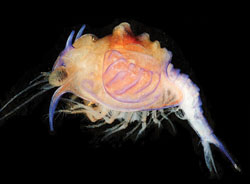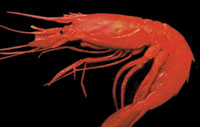Mysterious 'Monster Larva' Unmasked

The bewildering C. monstrosa now moves from nature's curiosity bin into the realm of shrimp.
Darryl Felder
In life as in fiction, monsters are rarely what they seem. And now researchers have added to the evidence an ocean oddity that sparked nearly two centuries of head scratching.
A team of researchers led by GW biologist Keith Crandall reported last fall that a curious crustacean named Cerataspis monstrosa, a larva previously unmatched to an adult animal, is actually an early developmental stage of a species of deep-water shrimp, Plesiopenaeus armatus.
When the so-called "monster larva" was first found in 1828 inside the gut of a dolphin, baffled scientists described it as a "monstrous and misshapen animal," the study authors wrote in the article, which was featured on the cover of the journal Ecology and Evolution.
The issue of larvae that bear no resemblance to their adult selves does arise with some species. Answers sometimes can be found by allowing larvae to mature in a lab, or in a species' affinity for a particular habitat.

The deep-sea shrimp that researchers have identified as the adult form of the mysterious "monster larva."
Darryl Felder
But C. monstrosa sightings are fairly rare—it mostly turns up only after being eaten, the researchers wrote—and as it matures the creature's preference of habitat changes, too.
So when a lone "monster larva" recently was found in the Gulf of Mexico, the research team took the opportunity to explore the DNA evidence. Genetic comparisons of C. monstrosa and members of a family of deep-sea shrimp, which was long suspected of sharing a link, identified a "near perfect" genetic match in P. armatus, the researchers wrote.
Studies linking larvae and adults "not only aid in our understanding of biodiversity, they provide insights into the life history, distribution, and ecology of an organism," says Dr. Crandall.
—Danny Freedman
